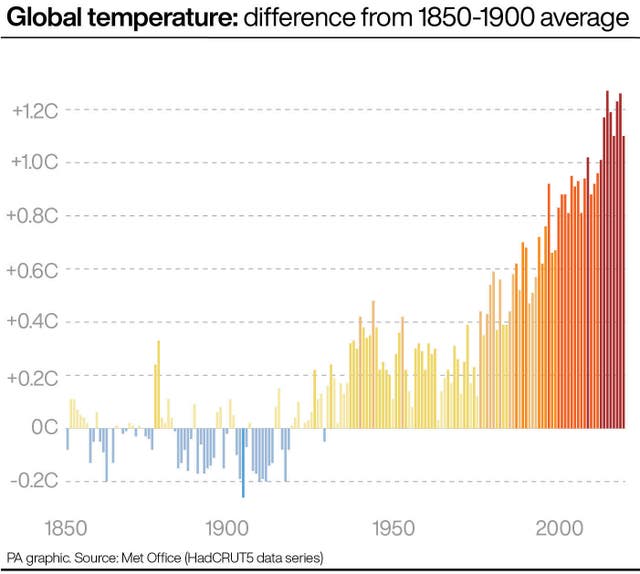Last year was one of the seven warmest years on record, despite the cooling effects of the natural “La Nina” weather pattern, UN experts have said.
The World Meteorological Organisation (WMO) said a series of global datasets showed 2021 was the seventh year in a row where the temperature has been more than 1C above pre-industrial levels.
An assessment collating the six datasets, including one compiled by the Met Office and the University of East Anglia (UEA), reveals last year was around 1.1C warmer than the 1850-1900 average.
That is despite the presence of La Nina events, a large-scale cooling of the ocean surface temperatures in parts of the Pacific Ocean and changes in tropical atmospheric circulation which temporarily cool global temperatures, in 2020-2022.
The Met Office and UEA’s dataset puts 2021 as the joint sixth-warmest year on record, while other datasets put it between the fifth and seventh warmest year, with small differences between the different analyses.
The WMO said global warming and other climate impacts were expected to continue due to heat-trapping greenhouse gases in the atmosphere which have continued to rise to new record highs.

WMO secretary-general, Professor Petteri Taalas said: “Back-to-back La Nina events mean that 2021 warming was relatively less pronounced compared to recent years.
“Even so, 2021 was still warmer than previous years influenced by La Nina.
“The overall long-term warming as a result of greenhouse gas increases is now far larger than the year-to-year variability in global average temperatures caused by naturally occurring climate drivers.”
He added that 2021 would be remembered for record-shattering temperatures in Canada, deadly flooding in Asia and Europe and drought in parts of Africa and South America.
“Climate change impacts and weather-related hazards had life-changing and devastating impacts on communities on every single continent,” he said.
The warmest seven years on record have all occurred since 2015, with 2016, 2019 and 2020 the hottest three.
An exceptionally strong El Nino pattern, which has the reverse effect of a La Nina by pushing global temperatures up, occurred in late 2015 and continued into early 2016, helping propel the year into the hottest spot.
Dr Colin Morice, of the Met Office, said: “2021 is one of the warmest years on record, continuing a series of measurements of a world that is warming under the effects of greenhouse gas emissions.
“This extends a streak of notably warm years from 2015 to 2021 – the warmest seven years in over 170 years of measurements.”
Prof Tim Osborn, of the University of East Anglia, added: “Each year tends to be a little below or a little above the underlying long-term global warming.
“Global temperature data analysed by the Met Office and UEA’s Climatic Research Unit show 2021 was a little below, while 2020 had been a little above, the underlying warming trend.
“All years, including 2021, are consistent with long-standing predictions of warming due to human activities.”
Countries have agreed to take action to try to limit global warming to 1.5C above pre-industrial levels to avoid the worst impacts of climate change, including more extreme floods, storms, heatwaves and damage to crops.
But while nations meeting at the UN climate summit in Glasgow last November, Cop26, reaffirmed their commitment to trying to meet the 1.5C limit, scientists warn much greater, faster cuts are needed in fossil fuel emissions and other pollutants that drive rising temperatures.




Comments: Our rules
We want our comments to be a lively and valuable part of our community - a place where readers can debate and engage with the most important local issues. The ability to comment on our stories is a privilege, not a right, however, and that privilege may be withdrawn if it is abused or misused.
Please report any comments that break our rules.
Read the rules here